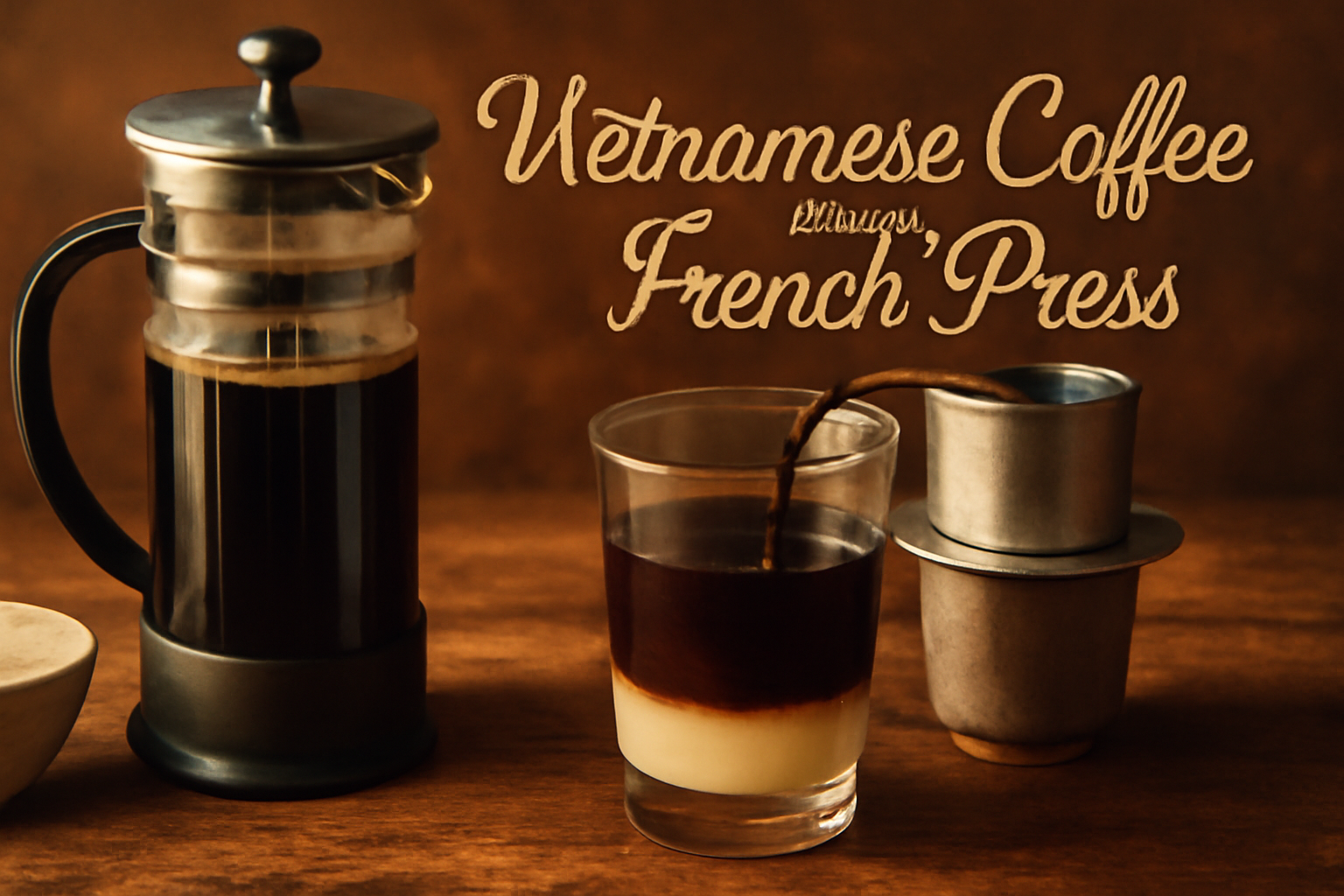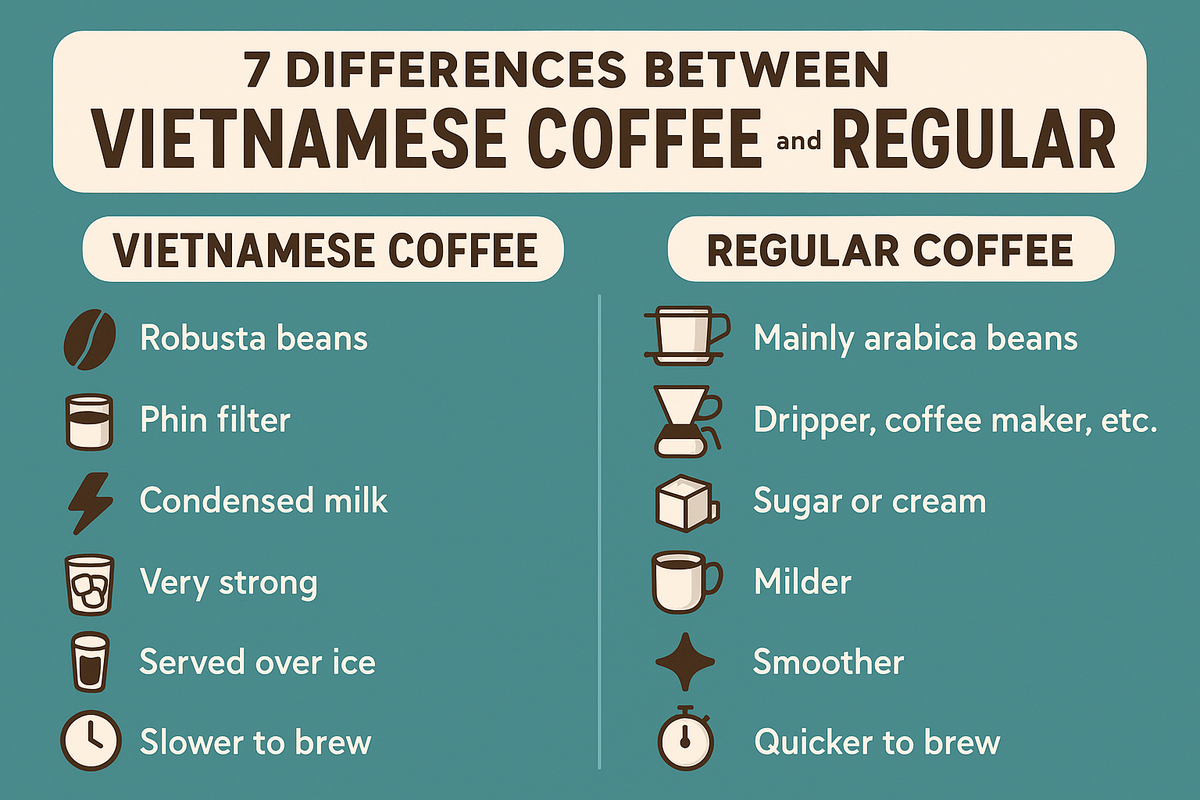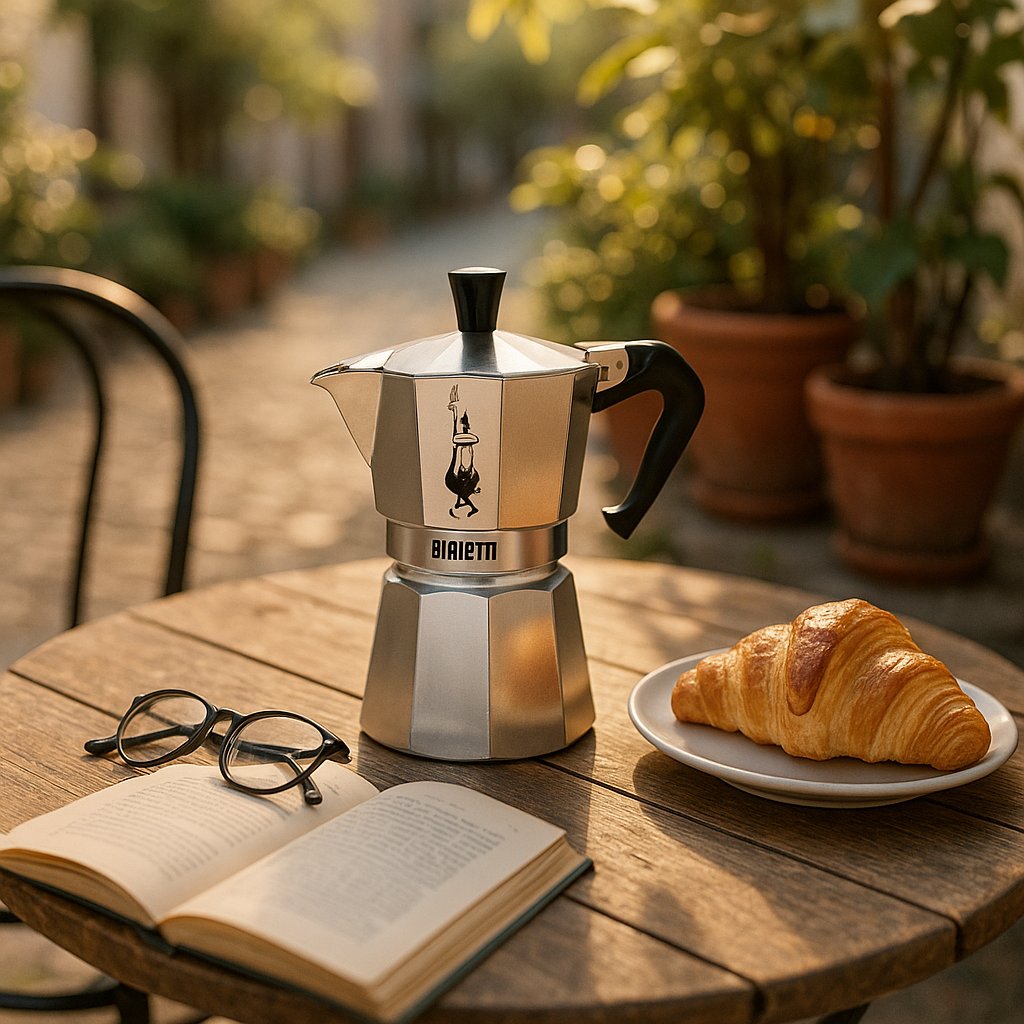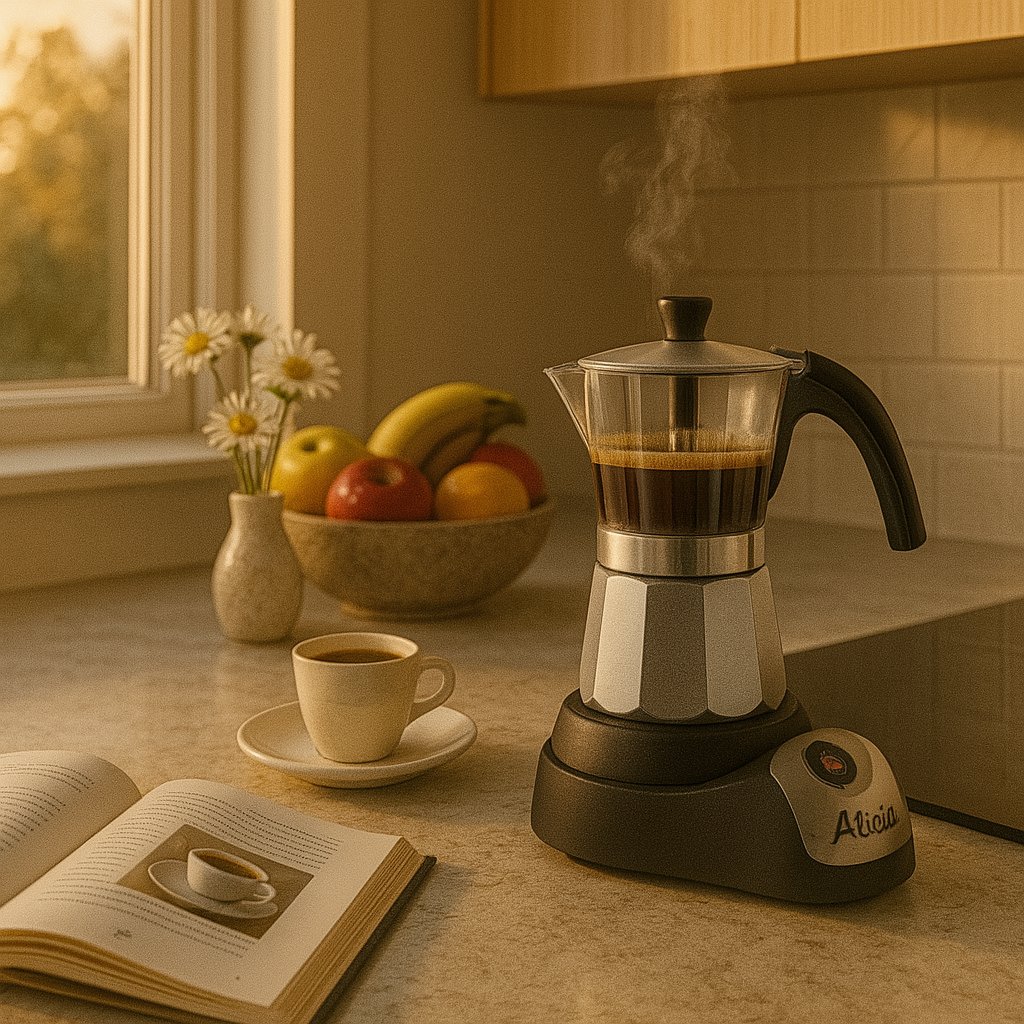Can You Make Vietnamese Coffee with a French Press?
Discover Marco's proven techniques for brewing authentic Vietnamese coffee using a French press. Learn the perfect ratios, step-by-step methods, and professional secrets for creating that distinctive Vietnamese coffee experience without a traditional phin filter.

Introduction: From Hanoi Streets to Your Kitchen
I'll never forget my first morning in Hanoi's Old Quarter, sitting on a tiny plastic stool, watching the vendor slowly drip Vietnamese coffee through a traditional phin filter. The process was mesmerizing—each drop of dark, concentrated coffee building anticipation for that first sweet, strong sip. But when I returned home to Rome and tried to recreate that experience, I faced a common problem: I didn't have a phin filter, and importing one seemed excessive for my weekly Vietnamese coffee cravings.
That's when I embarked on a mission that took me from the coffee shops of Berlin to the specialty roasters of Seattle: could I capture the essence of Vietnamese coffee using equipment I already owned? After months of experimentation and countless conversations with Vietnamese immigrants who shared their grandmother's secrets, I discovered something remarkable—you absolutely can make authentic Vietnamese coffee with a French press.
But here's the catch: it's not just about throwing Vietnamese coffee beans into your French press and hoping for the best. Authentic Vietnamese coffee has specific characteristics—it's bold, concentrated, slightly sweet from the brewing process itself, and has a unique mouthfeel that comes from the interaction between robusta beans and traditional brewing methods. Recreating this with a French press requires understanding the science behind Vietnamese coffee and adapting your technique accordingly.
Marco's Quick Answer
Yes, you can definitely make Vietnamese coffee with a French press! The key is using the right coffee-to-water ratio (1:4), the correct grind size (medium-coarse), and a modified brewing technique that mimics the slow extraction of a phin filter. I'll show you exactly how.
Understanding Vietnamese Coffee: What Makes It Special
The Traditional Phin Filter Method
Before we dive into French press alternatives, it's crucial to understand what makes Vietnamese coffee unique. Traditional Vietnamese coffee uses a phin filter—a small metal drip filter that sits directly on your cup. This method creates coffee that's approximately 3-4 times stronger than regular drip coffee, with a brewing process that takes 4-5 minutes and produces about 2-3 ounces of concentrated coffee.
The phin filter works through slow extraction: hot water is poured over coarsely ground coffee, and gravity slowly pulls it through the grounds. This creates a coffee concentrate that's then typically mixed with sweetened condensed milk. The result is a drink that's bold but not bitter, with a full body and distinctive flavor profile that combines the robusta beans' natural characteristics with the unique extraction method.
Key Characteristics We Need to Replicate
Concentration Level
- • Coffee-to-water ratio: 1:4 to 1:5
- • Final volume: 2-3 oz concentrate
- • Strength: 3-4x regular coffee
- • Extraction time: 4-5 minutes
Flavor Profile
- • Bold but not bitter
- • Full-bodied mouthfeel
- • Natural sweetness from slow extraction
- • Clean finish despite strength
Understanding Robusta vs. Arabica
Vietnamese coffee traditionally uses robusta beans, which have twice the caffeine content of arabica and a more intense, earthy flavor. Robusta beans also produce more crema and have a naturally fuller body—characteristics that work perfectly with the slow extraction method and pair beautifully with sweetened condensed milk.
Why a French Press Actually Works for Vietnamese Coffee
The Science Behind the Compatibility
At first glance, a French press and a phin filter seem completely different—one uses immersion brewing while the other uses drip extraction. However, they share crucial characteristics that make the French press an excellent substitute for making Vietnamese coffee. Both methods allow for extended contact time between water and coffee grounds, both work best with coarser grinds, and both can produce concentrated coffee when the ratios are adjusted correctly.
The key insight I discovered during my experimentation in Seattle came from understanding that Vietnamese coffee's distinctive character comes not just from the equipment, but from three critical factors: the high coffee-to-water ratio, the extraction time, and the water temperature. A French press can replicate all three of these elements when used with the right technique.
Advantages of Using a French Press
Why French Press Works Better Than You'd Think
- Full Immersion Control: Unlike drip methods, you control exactly how long the coffee steeps
- Temperature Stability: The glass or steel construction maintains water temperature throughout brewing
- Filtration Flexibility: The metal mesh allows oils and fine particles through, creating body similar to phin coffee
- Ratio Precision: Easy to measure exact coffee-to-water ratios for consistent results
- Larger Batch Capability: Can make multiple servings at once, perfect for entertaining
- Equipment Accessibility: Most coffee enthusiasts already own a French press
Addressing Common Concerns
The most frequent objection I hear is: "But French press coffee tastes completely different from Vietnamese coffee!" This is absolutely true—when you use typical French press ratios and techniques. The magic happens when you adapt the French press method to replicate Vietnamese brewing parameters. This means using much more coffee, adjusting grind size, modifying steeping time, and even changing how you press and serve the coffee.
Important Reality Check
Will French press Vietnamese coffee taste exactly like phin-filtered coffee? No—and that's okay! What you'll get is a delicious, authentic-tasting Vietnamese-style coffee that captures the essence of the original. Many of my Vietnamese friends prefer the French press method for its consistency and convenience.
Essential Equipment and Ingredients
Equipment Needed
Must-Have Equipment
- French Press: 34 oz (1 liter) size recommended for best results
- Digital Scale: Essential for measuring precise coffee-to-water ratios
- Burr Grinder: For consistent, medium-coarse grind size
- Timer: Critical for timing the 4-minute extraction
- Thermometer: To ensure proper water temperature (195-205°F)
- Small Measuring Cups: For portioning the concentrate
Optional But Helpful
- Fine-Mesh Strainer: For double-filtering if you prefer cleaner coffee
- Gooseneck Kettle: Better control over water pouring
- Coffee Warmer/Hot Plate: To keep coffee warm during the process
- Glass Shot Glasses: For serving individual portions authentically
Coffee Selection Guide
Ideal Coffee Choices
- Vietnamese Robusta: Authentic choice, high caffeine
- Dark Roast Robusta: Available at specialty stores
- French Roast Arabica: Good substitute for robusta
- Italian Roast Blends: Often contain robusta
What to Look For
- • Roast date within 2-4 weeks
- • Dark to medium-dark roast level
- • Whole beans (grind fresh)
- • Tasting notes: chocolate, nuts, earth
Additional Ingredients
Traditional Vietnamese Coffee Accompaniments
- Sweetened Condensed Milk: Essential for ca phe sua (Vietnamese milk coffee)
- Hot Water: For ca phe den nong (hot black coffee)
- Ice Cubes: For ca phe sua da (iced Vietnamese coffee)
- Sugar: Optional, as condensed milk provides sweetness
Step-by-Step French Press Vietnamese Coffee Method
Marco's Perfect Vietnamese Coffee Recipe
Serving Size: 2-3 servings of Vietnamese coffee
Prep Time: 5 minutes
Brew Time: 4 minutes
Coffee-to-Water Ratio: 1:4 (much stronger than regular French press)
Preparation Phase
Heat Your Water
Heat water to 200°F (93°C). This is slightly cooler than typical French press brewing, which helps prevent over-extraction with the high coffee-to-water ratio. If you don't have a thermometer, bring water to a boil and let it sit for 30 seconds.
Measure and Grind Coffee
Use 60g (about 12 tablespoons) of coffee beans for 240ml (1 cup) of water. Grind to medium-coarse consistency—think coarse sea salt. This grind size allows for proper extraction without over-extraction during the 4-minute steep.
Warm Your French Press
Pour hot water into your French press, swirl it around, and pour it out. This preheating step is crucial for maintaining temperature throughout the brewing process and ensures optimal extraction.
Brewing Phase
Add Coffee and Initial Water
Add the ground coffee to your French press. Pour just enough hot water to wet the grounds (about 60ml). This "bloom" phase allows CO2 to escape and ensures even extraction. Let it sit for 30 seconds.
Complete the Pour
Add the remaining water slowly, pouring in a circular motion to ensure all grounds are saturated. Place the plunger on top but do NOT press down yet. Start your 4-minute timer.
The Steep
Let the coffee steep for exactly 4 minutes. This timing mimics the slow drip of a phin filter. During this time, gently stir once at the 2-minute mark to ensure even extraction.
Press and Serve
Press the plunger down slowly and steadily—this should take about 30 seconds. Pour immediately to prevent over-extraction. You should have about 180-200ml of concentrated coffee.
Timing Is Everything
The 4-minute steep time is crucial for replicating the phin filter experience. Shorter steeping results in weak coffee, while longer steeping can lead to bitterness. Set a timer and stick to it religiously.
Perfect Ratios and Delicious Variations
Understanding Vietnamese Coffee Ratios
Getting the ratios right is what separates authentic Vietnamese coffee from a strong cup of coffee. Through my extensive testing, I've developed ratios that consistently produce the concentrated, flavorful coffee that makes Vietnamese coffee special. These ratios are quite different from typical French press brewing and require some adjustment if you're used to Western coffee preparation.
Strong Vietnamese Coffee (Traditional)
- Coffee: 60g (12 tablespoons)
- Water: 240ml (1 cup)
- Ratio: 1:4
- Yield: 180-200ml concentrate
- Best for: Traditional ca phe sua
Medium Vietnamese Coffee (Beginner-Friendly)
- Coffee: 50g (10 tablespoons)
- Water: 250ml (1 cup + 2 tbsp)
- Ratio: 1:5
- Yield: 200-220ml concentrate
- Best for: First-time makers
Classic Vietnamese Coffee Variations
Ca Phe Sua Nong (Hot Vietnamese Milk Coffee)
The most popular Vietnamese coffee variation, this is what most people think of when they hear "Vietnamese coffee."
- Add 2-3 tablespoons sweetened condensed milk to your cup
- Pour the hot concentrated coffee over the condensed milk
- Stir well to combine—the coffee should turn a beautiful caramel color
- Serve immediately while hot
Ca Phe Sua Da (Iced Vietnamese Coffee)
Perfect for hot days, this refreshing version is incredibly popular in Vietnam and Vietnamese restaurants worldwide.
- Fill a tall glass with ice cubes
- Add 2-3 tablespoons sweetened condensed milk
- Pour the hot concentrated coffee over the ice and condensed milk
- Stir vigorously to create the signature layered effect
Ca Phe Den (Black Vietnamese Coffee)
For purists who want to taste the coffee itself, this version showcases the unique flavor of Vietnamese coffee beans.
- Serve the concentrated coffee straight, without any additions
- Optionally add 1-2 teaspoons of sugar if desired
- Best enjoyed in small portions (2-3 oz) like espresso
- Perfect for appreciating the robusta bean characteristics
Adjusting to Your Taste
These ratios produce authentic Vietnamese coffee strength, but feel free to adjust according to your preference. Start with the medium ratio if you're new to Vietnamese coffee, then gradually increase the strength as you develop a taste for it.
Troubleshooting Common Issues
Coffee Quality Problems
❌ Problem: Coffee tastes too bitter
Causes: Over-extraction, water too hot, grind too fine, steeping too long
Solutions:
- Reduce water temperature to 195°F
- Use a coarser grind setting
- Reduce steeping time to 3.5 minutes
- Try a different coffee—some robusta can be naturally bitter
⚠️ Problem: Coffee is too weak
Causes: Insufficient coffee grounds, grind too coarse, water not hot enough
Solutions:
- Increase coffee amount by 10g and adjust water accordingly
- Use a slightly finer grind
- Ensure water temperature reaches 200°F
- Check if your coffee beans are fresh (within 2-4 weeks of roast date)
ℹ️ Problem: Coffee has muddy texture
Causes: Grind too fine, pressing too aggressively, old French press filter
Solutions:
- Use a coarser grind—you should see distinct particles
- Press the plunger down slowly over 30 seconds
- Check and clean your French press filter mesh
- Consider double-filtering through a fine-mesh strainer
Consistency Issues
Achieving Consistent Results
Key factors for consistency:
- Always use a scale—eyeballing measurements leads to inconsistent results
- Grind coffee fresh for each brew—pre-ground coffee loses oils quickly
- Keep a brewing log to track what works for your taste preferences
- Use the same French press each time—different sizes affect ratios
- Store coffee beans in an airtight container away from light and heat
Conclusion: Bringing Vietnam to Your Kitchen
After countless experiments from Rome to Seattle, I can confidently say that French press Vietnamese coffee isn't just a substitute—it's a worthy brewing method in its own right. While it may not be identical to phin-filtered coffee, it captures the soul of Vietnamese coffee: the bold strength, the rich body, and that perfect harmony with sweetened condensed milk that makes each sip a small celebration.
The beauty of this method lies in its accessibility. You don't need to import specialized equipment or travel to Vietnam to experience authentic Vietnamese coffee culture. With a French press, quality coffee beans, and the techniques I've shared, you can create a morning ritual that connects you to the vibrant coffee culture of Vietnam every single day.
What I love most about making Vietnamese coffee with a French press is how it encourages mindfulness. The precise measuring, the careful timing, the anticipation during the 4-minute steep—it transforms your morning coffee from a rushed necessity into a meditative practice. And when you take that first sip of perfectly balanced ca phe sua, with its layers of bitter coffee and sweet condensed milk, you're not just drinking coffee—you're participating in a tradition that spans generations.
Remember, perfection comes with practice. Your first few attempts might not match the exact flavor profile you're imagining, and that's completely normal. Each bag of coffee beans is different, each French press behaves slightly differently, and your taste preferences are unique. Keep notes, make adjustments, and most importantly, enjoy the journey of discovery.
The Vietnamese have a saying: "Cà phê không chỉ là thức uống, mà là văn hóa"—Coffee is not just a drink, but a culture. By learning to make Vietnamese coffee with a French press, you're not just expanding your brewing skills; you're embracing a culture that values patience, quality, and the simple pleasure of sharing a perfect cup of coffee with the people you care about.
So tomorrow morning, when you reach for your French press, remember that you're carrying forward a tradition that began in the colonial coffee plantations of Vietnam and has traveled the world to land in your kitchen. Make it with intention, serve it with pride, and share it with others—because the best Vietnamese coffee, whether made with a phin filter or a French press, is always better when shared.





